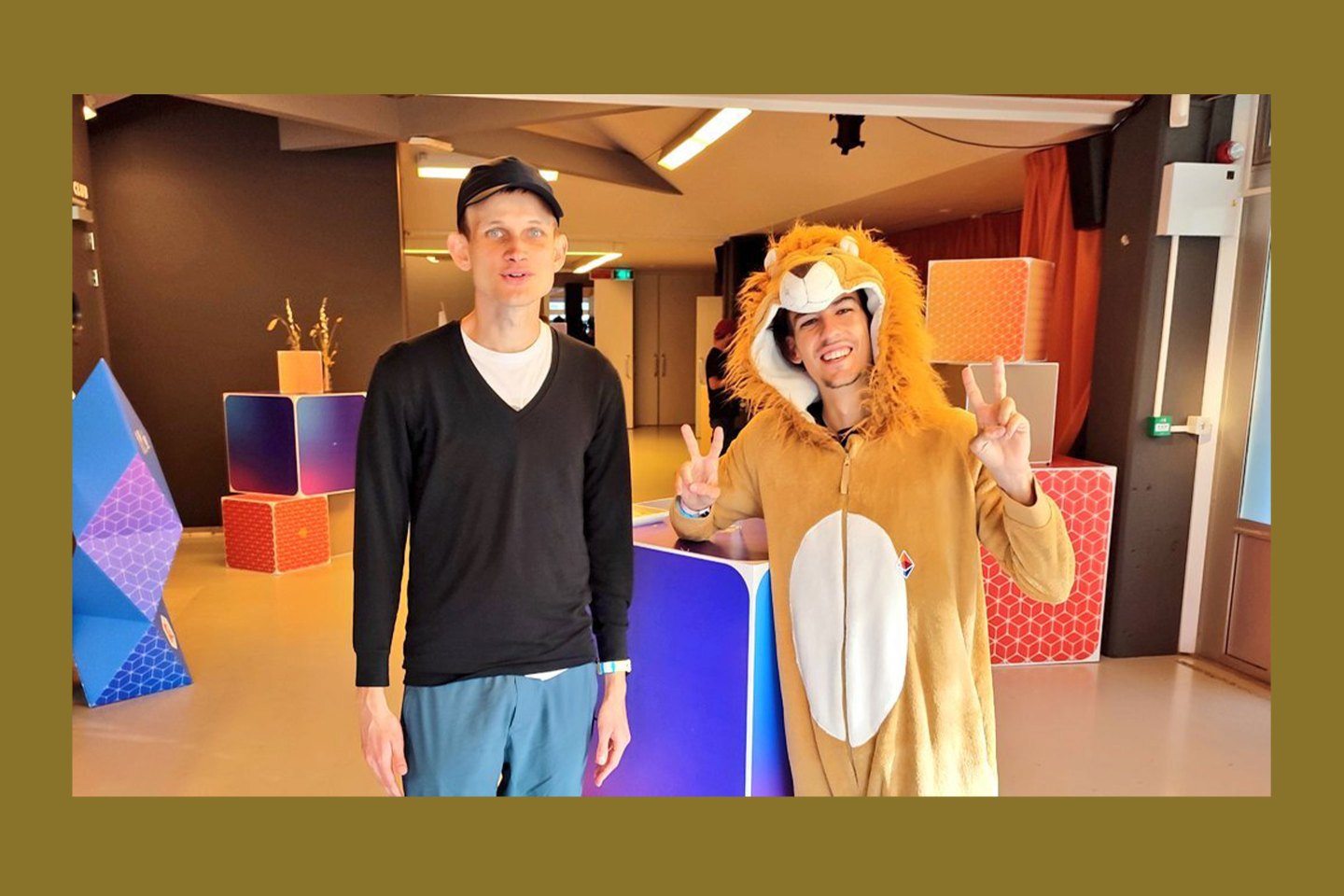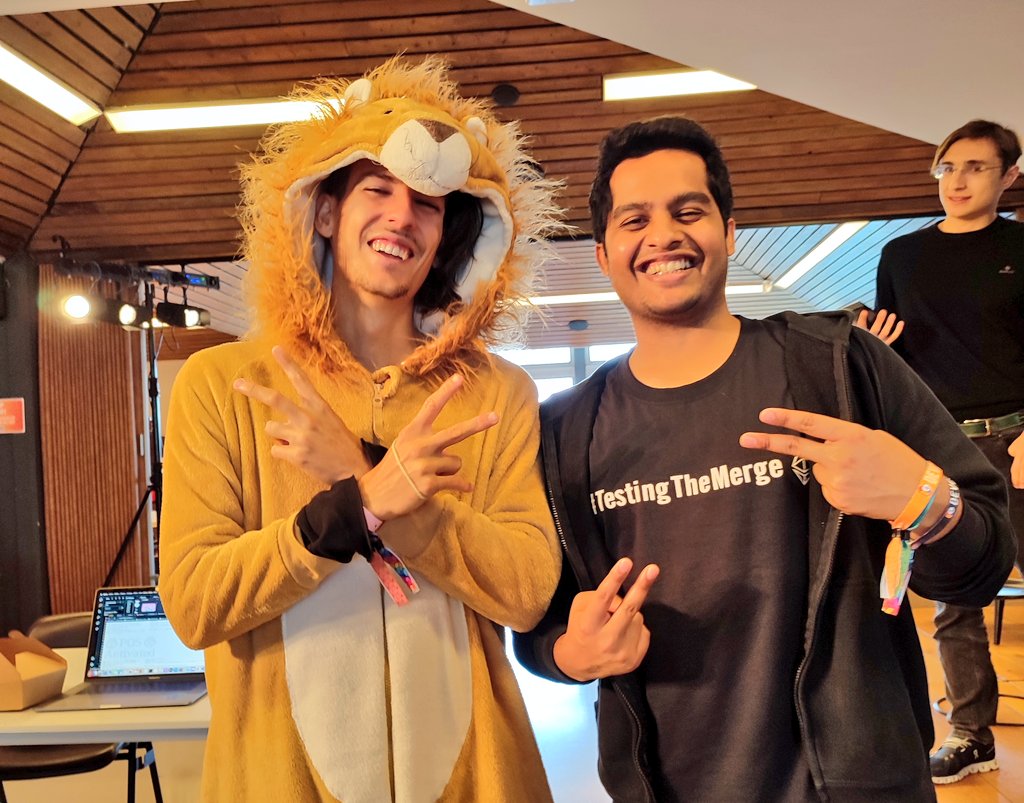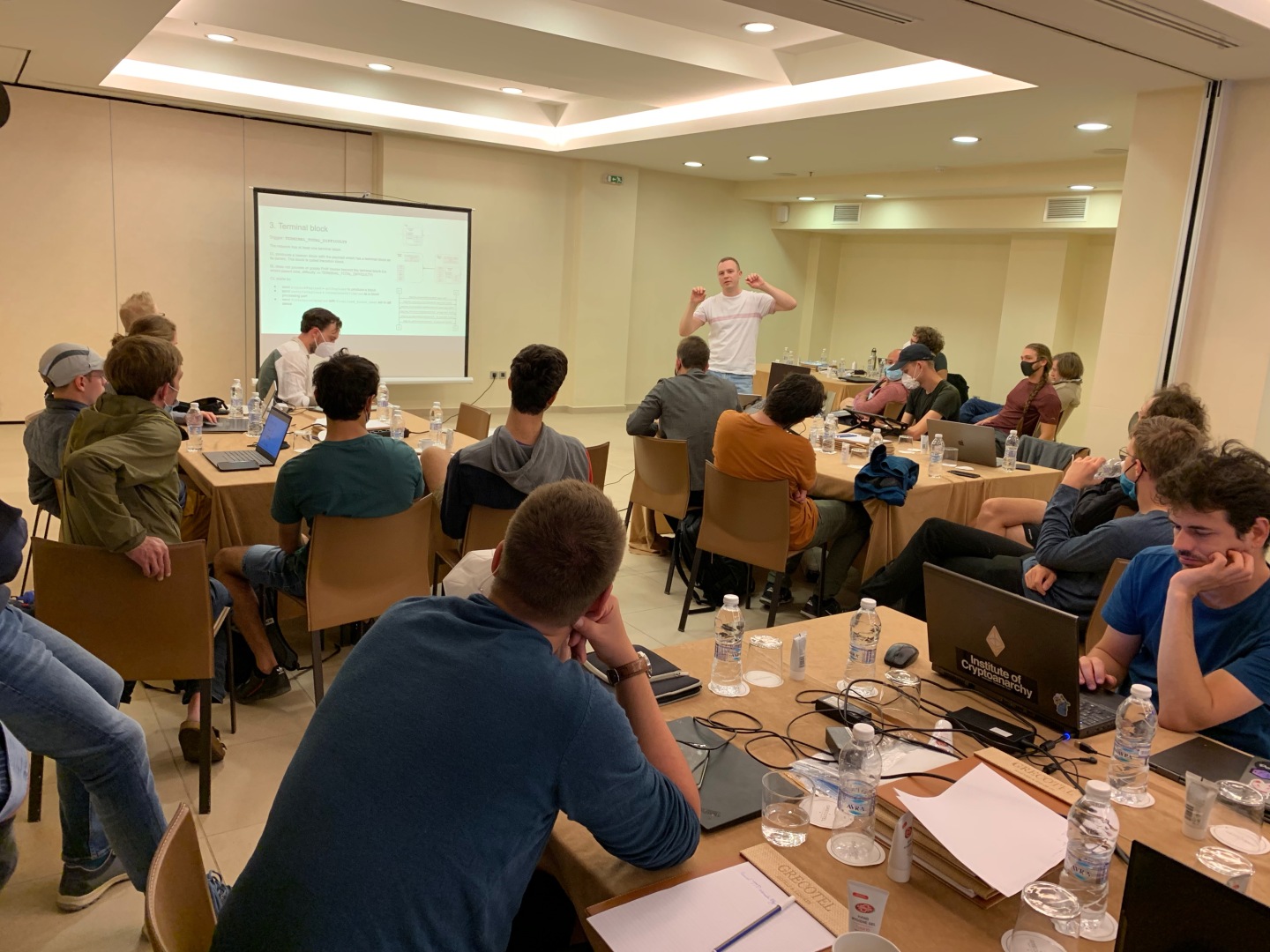以太坊合并复盘:这些幕后推手如何改变了历史

今年9月,当加密货币世界焦急地等待酝酿多年的以太坊(Ethereum)合并时,一群为该项目奉献了毕生精力的软件开发工程师、研究员和社区成员感到压力骤升。
不过,当倒计时牌来到美国东部时间9月15日凌晨2点30分的时候,这群人并没有兴奋得不能自己。就像整个加密货币社区一样,他们也在估计的合并时间不断迫近之际,不停地发送推文。那一刻,他们聚集在德国柏林的以太坊基金会(Ethereum Foundation)的办公室里,围坐在电脑旁,通过Zoom视频电话讨论进展,分享个人轶事,最后一起庆祝。当时正好赶上著名的黑客马拉松大赛EthBerlin。在那里,来自世界各地的以太坊人汇聚一堂,共贺他们为之奋斗终生的事业。
然而,即使支持者数不胜数,质疑声却仍然此起彼伏。比如,一些人指出,以太坊合并缘何屡屡推迟;在一个活跃如斯的庞大网络上,如此规模的升级缘何从未进行过。
令他们惊讶的是,以太坊的权益证明链(PoS)在美国东部时间9月15日凌晨3点左右开始合拢。围观者实时见证了加密货币领域的一个历史性时刻。就在这时,艺术家乔纳森·曼恩秉承纯正的以太坊风格,延续了他长期以来的传统,在社区Zoom上演唱了一首以太坊主题的歌曲,这也是他在合并前测试期间的多次电话会议上保持的习惯。最新一首献给合并的歌曲包含这样一段歌词:“碳足迹都消失了,这就是为什么我们要高唱合并之歌。”
我们搞定了!
合并大吉!这是以太坊生态系统的重要时刻。所有参与合并的人今天都应该非常自豪。
——维塔利克·布特林(@VitalikButerin),2022年9月15日
成功合拢获得确认后,合并正式完成,开发者和旁观者都欢呼起来。
在外人看来,这种场面似乎来得毫无道理。他们认为,所谓的合并只不过是一次无聊的软件升级。但对于肩负合并重任的团队来说,它不仅仅是一项技术壮举。毫无疑问,对于以太坊和整个加密货币领域来说,这是一个非常重要的里程牌。除此之外,这也是一条不平凡的成功之路:夜以继日的工作、无数次测试、研讨会、聚会、黑客马拉松大赛和不辞辛苦的旅行,而参与其中的开发人员最终也成为加密货币社区的明星。数十名开发者和研究员跨越年龄和文化障碍,设法联系在一起,一周又一周的亲密合作,协力构建以太坊,并为合并做各种准备。那么,他们究竟是如何做到的?
“对我来说,这是一个重要时刻”
合并历经漫长的等待才得以启动。自以太坊诞生之日起,创建者维塔利克·布特林与软件开发工程师和研究员就一直筹划将这个网络转入权益证明机制。
以太坊软件公司ConsenSys的首席研究员米哈伊尔·加里宁每天会花10个小时来钻研这个转换过程。但这位享誉业界的技术大咖告诉《财富》杂志,他从来没有觉得这是在工作。
现年35岁的加里宁是以太坊领域的元老级人物:早在以太坊“主网”在2015年启动前的一个月,他就开始勠力打造以太坊的生态系统,并最终被称为合并的幕后“策划者”。事实上,其他开发者透露称,没有他,合并就无从谈起。
2020年11月,加里宁发布了一个旨在建立“可执行信标链”(Executable Beacon Chain)的提议。一个月后,信标链(即以太坊的权益证明链)正式启用。
“看到我不知疲倦做出来的东西开始投产,将被其他人使用——对我来说,这是一个重要时刻。”Prysmatic Labs实验室的创始人、常驻美国旧金山的以太坊软件工程师特伦斯·曹这样说道。自2018年以来,现年34岁的特伦斯一直与团队从事这项研究,也见证了合并的早期研发进展。彼时,这个过程还没有被称为“合并”,甚至还不叫Eth2,大多时候被称为“Shasper”。后者是一个组合词,由当时的以太坊权益证明名称“Casper”,以及以太坊增容解决方案“sharding”合并而成。
从那时起,开发者和研究员一直潜心研究,并对合并过程进行了多次测试,而这些时光也成为团队成员最美好的回忆。例如,许多开发者和研究员对2021年10月在希腊举行的“双耳瓶”(Amphora)研讨会记忆犹新。
以太坊基金会的软件工程师马里厄斯·范德维登说:“第一次亲眼看到你在网上互动了这么久的人,真的很有趣,也着实令人兴奋。”他住在德国,从2020年开始执掌颇具人气的以太坊客户端Go Ethereum(Geth)。
对于轻松愉悦的以太坊社区来说,那次旅行特别符合他们一以贯之的形象。比如,来自以太坊客户端Lodestar、化名为Dapplion的以太坊核心开发者,在旅行的大部分时间都穿一件带有狮子造型的服装。“我在不同的日子里都穿着那套行头。”29岁的Dapplion笑着说。

但对26岁的范德维登来说,“最有趣的事情”并不是什么狮子服饰,而是见证了40多名软件工程师和研究员合住在希腊的一家五星级酒店,而且从未离开地下室那一幕。“从早到晚,我们都坐在这个狭小的房间里写代码,所有人都伏在电脑前。”范德维登回忆道。
他们的目标是取得进展,并“化解”合并转换方面的一些问题——他们确实做到了。他们当时还不知道的是,这将成为以太坊共识机制转向权益证明的一个重要“里程碑”。

“我们成功地证明了我们所使用的整体概念或架构是有效的。我认为,这是合并研发过程中最振奋人心的时刻。”这次旅行的组织者、以太坊基金会的协议支持主管蒂姆·贝科说。
以太坊基金会的开发运维工程师帕里索什·贾扬蒂透露称,在活动的最后一天,“我们想尝试在以太坊测试网络上真正实现合并。在所有人必须得离开前的5分钟,这项测试终于大功告成。”现年28岁的贾扬蒂于2020年加入团队,合并前的测试环节基本上都是由他负责。做成这件事的感觉“很奇妙,我永生难忘。”他说。

“晚上10点以后开会”
对这群人来说,长时间的昼夜工作并不罕见。对合并的全情投入、对以太坊的万丈热情,经常让他们无暇休息,更顾不上睡觉。此外,由于软件工程师和研究员来自不同的时区,其中包括澳大利亚、德国、印度、波兰、瑞士、英国和美国,工作时间不规律已经成为家常便饭。
以太坊基金会的研究员王晓薇(Hsiao-Wei Wang,音译)对此深有感触。她从2017年开始与团队一起研究以太坊生态系统,并对合并做出了多项贡献,她利用卡通熊猫制作的合并表情包更是风靡网络。为了更好地与同事沟通,这位来自中国台湾地区的研究员经常通宵达旦的工作。她告诉《财富》杂志:“我习惯了在晚上10点以后开会。”
敬请包涵。
——王晓薇(@icebearhww),2021年8月29日
但本·埃金顿指出,这种“巨大的合作”对以太坊的成功“至关重要”。埃金顿于2017年加入ConsenSys,目前负责著名的以太坊客户端Teku。“这就是我们想要建立的那种网络——一个没有人据为己有的网络,一个可以让开发者拥有巨大多样性的网络。”
就像其他加密货币社区一样,以太坊社区全天候在线。“我们往往工作在哪里,就住在哪里。所以很难关上门说:‘好啦,我今天的工作结束了。’况且我们所做的一切都很吸引人。一天下来感觉时间不够用,这激励我们必须利用好每时每刻。”

尽管每个人推动合并的动机可能有所不同,但大多数软件工程师和研究员都表示,减少以太坊对环境的影响是最重要的考量。在拥有气候动力学背景的埃金顿和他18岁的女儿看来,这种转变尤为重要。
“我跟她谈论非同质化代币(NFT)的时候,她简直疯了,严词质问我:‘你怎么能够这么做?你是想煮沸海洋吗?这可是我要面对的未来!’让我感到欣喜的是,我可以对她说:‘事实上,我毕生的工作就是要解决这个问题。这其实就是我正在做的事情。’”他说。“转向权益证明机制是必不可少的一步。”
贾扬蒂指出,许多为合并出力的人都认为,这番努力是“我们每个人为防止气候变化所能够做的最大贡献了。”他补充说,此举有望抵消“我一生中可能产生的碳排放。每每想到这一点,就觉得很疯狂。”
“50年或100年后,当人们回顾这次合并时,他们会感叹:‘哇,合并真的改变了历史。’”特伦斯·曹说。“这真的是大事件,但我觉得人们还没有意识到这一点。我们目前还处于非常早的阶段。”(财富中文网)
译者:任文科
今年9月,当加密货币世界焦急地等待酝酿多年的以太坊(Ethereum)合并时,一群为该项目奉献了毕生精力的软件开发工程师、研究员和社区成员感到压力骤升。
不过,当倒计时牌来到美国东部时间9月15日凌晨2点30分的时候,这群人并没有兴奋得不能自己。就像整个加密货币社区一样,他们也在估计的合并时间不断迫近之际,不停地发送推文。那一刻,他们聚集在德国柏林的以太坊基金会(Ethereum Foundation)的办公室里,围坐在电脑旁,通过Zoom视频电话讨论进展,分享个人轶事,最后一起庆祝。当时正好赶上著名的黑客马拉松大赛EthBerlin。在那里,来自世界各地的以太坊人汇聚一堂,共贺他们为之奋斗终生的事业。
然而,即使支持者数不胜数,质疑声却仍然此起彼伏。比如,一些人指出,以太坊合并缘何屡屡推迟;在一个活跃如斯的庞大网络上,如此规模的升级缘何从未进行过。
令他们惊讶的是,以太坊的权益证明链(PoS)在美国东部时间9月15日凌晨3点左右开始合拢。围观者实时见证了加密货币领域的一个历史性时刻。就在这时,艺术家乔纳森·曼恩秉承纯正的以太坊风格,延续了他长期以来的传统,在社区Zoom上演唱了一首以太坊主题的歌曲,这也是他在合并前测试期间的多次电话会议上保持的习惯。最新一首献给合并的歌曲包含这样一段歌词:“碳足迹都消失了,这就是为什么我们要高唱合并之歌。”
我们搞定了!
合并大吉!这是以太坊生态系统的重要时刻。所有参与合并的人今天都应该非常自豪。
——维塔利克·布特林(@VitalikButerin),2022年9月15日
成功合拢获得确认后,合并正式完成,开发者和旁观者都欢呼起来。
在外人看来,这种场面似乎来得毫无道理。他们认为,所谓的合并只不过是一次无聊的软件升级。但对于肩负合并重任的团队来说,它不仅仅是一项技术壮举。毫无疑问,对于以太坊和整个加密货币领域来说,这是一个非常重要的里程牌。除此之外,这也是一条不平凡的成功之路:夜以继日的工作、无数次测试、研讨会、聚会、黑客马拉松大赛和不辞辛苦的旅行,而参与其中的开发人员最终也成为加密货币社区的明星。数十名开发者和研究员跨越年龄和文化障碍,设法联系在一起,一周又一周的亲密合作,协力构建以太坊,并为合并做各种准备。那么,他们究竟是如何做到的?
“对我来说,这是一个重要时刻”
合并历经漫长的等待才得以启动。自以太坊诞生之日起,创建者维塔利克·布特林与软件开发工程师和研究员就一直筹划将这个网络转入权益证明机制。
以太坊软件公司ConsenSys的首席研究员米哈伊尔·加里宁每天会花10个小时来钻研这个转换过程。但这位享誉业界的技术大咖告诉《财富》杂志,他从来没有觉得这是在工作。
现年35岁的加里宁是以太坊领域的元老级人物:早在以太坊“主网”在2015年启动前的一个月,他就开始勠力打造以太坊的生态系统,并最终被称为合并的幕后“策划者”。事实上,其他开发者透露称,没有他,合并就无从谈起。
2020年11月,加里宁发布了一个旨在建立“可执行信标链”(Executable Beacon Chain)的提议。一个月后,信标链(即以太坊的权益证明链)正式启用。
“看到我不知疲倦做出来的东西开始投产,将被其他人使用——对我来说,这是一个重要时刻。”Prysmatic Labs实验室的创始人、常驻美国旧金山的以太坊软件工程师特伦斯·曹这样说道。自2018年以来,现年34岁的特伦斯一直与团队从事这项研究,也见证了合并的早期研发进展。彼时,这个过程还没有被称为“合并”,甚至还不叫Eth2,大多时候被称为“Shasper”。后者是一个组合词,由当时的以太坊权益证明名称“Casper”,以及以太坊增容解决方案“sharding”合并而成。
从那时起,开发者和研究员一直潜心研究,并对合并过程进行了多次测试,而这些时光也成为团队成员最美好的回忆。例如,许多开发者和研究员对2021年10月在希腊举行的“双耳瓶”(Amphora)研讨会记忆犹新。
以太坊基金会的软件工程师马里厄斯·范德维登说:“第一次亲眼看到你在网上互动了这么久的人,真的很有趣,也着实令人兴奋。”他住在德国,从2020年开始执掌颇具人气的以太坊客户端Go Ethereum(Geth)。
对于轻松愉悦的以太坊社区来说,那次旅行特别符合他们一以贯之的形象。比如,来自以太坊客户端Lodestar、化名为Dapplion的以太坊核心开发者,在旅行的大部分时间都穿一件带有狮子造型的服装。“我在不同的日子里都穿着那套行头。”29岁的Dapplion笑着说。
但对26岁的范德维登来说,“最有趣的事情”并不是什么狮子服饰,而是见证了40多名软件工程师和研究员合住在希腊的一家五星级酒店,而且从未离开地下室那一幕。“从早到晚,我们都坐在这个狭小的房间里写代码,所有人都伏在电脑前。”范德维登回忆道。
他们的目标是取得进展,并“化解”合并转换方面的一些问题——他们确实做到了。他们当时还不知道的是,这将成为以太坊共识机制转向权益证明的一个重要“里程碑”。
“我们成功地证明了我们所使用的整体概念或架构是有效的。我认为,这是合并研发过程中最振奋人心的时刻。”这次旅行的组织者、以太坊基金会的协议支持主管蒂姆·贝科说。
以太坊基金会的开发运维工程师帕里索什·贾扬蒂透露称,在活动的最后一天,“我们想尝试在以太坊测试网络上真正实现合并。在所有人必须得离开前的5分钟,这项测试终于大功告成。”现年28岁的贾扬蒂于2020年加入团队,合并前的测试环节基本上都是由他负责。做成这件事的感觉“很奇妙,我永生难忘。”他说。
“晚上10点以后开会”
对这群人来说,长时间的昼夜工作并不罕见。对合并的全情投入、对以太坊的万丈热情,经常让他们无暇休息,更顾不上睡觉。此外,由于软件工程师和研究员来自不同的时区,其中包括澳大利亚、德国、印度、波兰、瑞士、英国和美国,工作时间不规律已经成为家常便饭。
以太坊基金会的研究员王晓薇(Hsiao-Wei Wang,音译)对此深有感触。她从2017年开始与团队一起研究以太坊生态系统,并对合并做出了多项贡献,她利用卡通熊猫制作的合并表情包更是风靡网络。为了更好地与同事沟通,这位来自中国台湾地区的研究员经常通宵达旦的工作。她告诉《财富》杂志:“我习惯了在晚上10点以后开会。”
敬请包涵。
——王晓薇(@icebearhww),2021年8月29日
但本·埃金顿指出,这种“巨大的合作”对以太坊的成功“至关重要”。埃金顿于2017年加入ConsenSys,目前负责著名的以太坊客户端Teku。“这就是我们想要建立的那种网络——一个没有人据为己有的网络,一个可以让开发者拥有巨大多样性的网络。”
就像其他加密货币社区一样,以太坊社区全天候在线。“我们往往工作在哪里,就住在哪里。所以很难关上门说:‘好啦,我今天的工作结束了。’况且我们所做的一切都很吸引人。一天下来感觉时间不够用,这激励我们必须利用好每时每刻。”
尽管每个人推动合并的动机可能有所不同,但大多数软件工程师和研究员都表示,减少以太坊对环境的影响是最重要的考量。在拥有气候动力学背景的埃金顿和他18岁的女儿看来,这种转变尤为重要。
“我跟她谈论非同质化代币(NFT)的时候,她简直疯了,严词质问我:‘你怎么能够这么做?你是想煮沸海洋吗?这可是我要面对的未来!’让我感到欣喜的是,我可以对她说:‘事实上,我毕生的工作就是要解决这个问题。这其实就是我正在做的事情。’”他说。“转向权益证明机制是必不可少的一步。”
贾扬蒂指出,许多为合并出力的人都认为,这番努力是“我们每个人为防止气候变化所能够做的最大贡献了。”他补充说,此举有望抵消“我一生中可能产生的碳排放。每每想到这一点,就觉得很疯狂。”
“50年或100年后,当人们回顾这次合并时,他们会感叹:‘哇,合并真的改变了历史。’”特伦斯·曹说。“这真的是大事件,但我觉得人们还没有意识到这一点。我们目前还处于非常早的阶段。”(财富中文网)
译者:任文科
As the cryptocurrency world anxiously awaited the years-in-the-making Ethereum merge last week, a group of developers, researchers, and community members who’ve dedicated their lives to the project felt the pressure mount.
But counting down the blocks as the time passed 2:30 a.m. EST on Sept. 15, the group didn’t waver in excitement. They, alongside the greater cryptocurrency community, were sending tweets as the estimated timing for the merge got closer and closer. Those gathered IRL at the Ethereum Foundation office in Berlin—just in time for the notable hackathon EthBerlin, where Ethereans meet from all over the world to celebrate the project to which they’ve dedicated their lives—were huddled around their computers on a Zoom call to discuss progress, share war stories, and, finally, celebrate.
However, even with all the support, doubters remained, some citing how the merge had been delayed so many times in the past, and how an upgrade of this scope, on an active network of this size, had never been done.
To their surprise, the Ethereum proof-of-stake chain began to finalize around 3 a.m. EST, and onlookers witnessed in real time a historic moment in cryptocurrency history. And as it happened, in true Etherean fashion, artist Jonathan Mann continued his long-standing tradition of singing Ethereum-themed songs on community Zooms—a custom he adopted over the course of multiple pre-merge test calls. His latest tune dedicated to the merge included the lyrics: “Carbon footprint is all gone, that’s why we’re singin’ the merge song.”
And we finalized!
Happy merge all. This is a big moment for the Ethereum ecosystem. Everyone who helped make the merge happen should feel very proud today.
— vitalik.eth (@VitalikButerin) September 15, 2022
With success then assured, the merge was complete, and developers and watchers alike cheered.
To outsiders, the spectacle might’ve seemed unwarranted, thinking the merge is just some boring software upgrade. But for the team responsible, it’s much more than merely a technological feat. Aside from being a hugely important milestone for Ethereum and the greater cryptocurrency sector, the road leading to it was one of 24/7 work, countless tests, workshops, meetups, hackathons, and travel for developers—who became figureheads within the crypto community. Ranging across generations and cultures, the scores of developers and researchers managed to connect and collaborate—week in, week out—to build Ethereum and prepare for the merge. Here’s how they did it.
“Big moment for me”
The merge was a long time coming. Since Ethereum’s genesis, creator Vitalik Buterin, alongside developers and researchers, planned to move the network to proof of stake.
Mikhail Kalinin, lead researcher at prominent Ethereum software company ConsenSys, would spend 10 hours per day working on it—but it never felt much like work, he told Fortune.
Kalinin, 35, is an Ethereum OG: He started working on the Ethereum ecosystem in 2015—a month before the Ethereum mainnet, or main public chain, launched—and ultimately became known as the “mastermind” behind the merge. In fact, other developers say that without him, the merge wouldn’t have happened.
In November 2020, Kalinin published a proposal for the “Executable Beacon Chain,” and a month later, the Beacon Chain, Ethereum’s proof-of-stake chain, shipped.
That was a “big moment for me—seeing something that I’ve worked very tirelessly on in production that other people will be using,” said Terence Tsao, founder of Prysmatic Labs and an Ethereum developer out of San Francisco. Working with the team since 2018, Tsao, 34, also saw the development of the merge in its earliest stages—back before it was called the merge, or even Eth2, and was mostly referred to as “Shasper,” a combination of “Casper,” the then-name for Ethereum’s version of proof of stake, and “sharding,” an Ethereum scaling solution.
Since then, developers and researchers have worked on and tested the merge process many times—and those times became favorite memories for team members. For one, developers and researchers recall the October 2021 “Amphora” workshop in Greece.
“It was really interesting and exciting to see people that you’ve interacted with online first for so long in person,” said Ethereum Foundation software developer Marius van der Wijden, who’s based in Germany and has led work on the popular Go Ethereum (Geth) client since 2020.
That trip was very on-brand for the lighthearted Ethereum community. For example, Dapplion, a pseudonymous Ethereum core developer at Lodestar, wore a lion costume for most of the trip. “I was wearing that suit on different days,” said Dapplion, 29, laughing.
But to van der Wijden, 26, the “funniest thing” wasn’t the lion costume. Instead, it was witnessing over 40 developers and researchers stay at a five-star hotel in Greece—and never leave the basement. “We sat there in this rather small room, coding, all hunched over computers, from morning to evening,” van der Wijden recalled.
Their goal was to make progress and “iron out” some issues regarding the merge transition—and they did just that. They didn’t know it at the time, but it would go down as a major “milestone” on Ethereum’s road to proof of stake.
“We managed to prove that the overall concept or architecture that we were using worked, and I think that was, with regards to the merge, the most energizing moment,” said Tim Beiko, the protocol support lead at the Ethereum Foundation who helped organize the trip.
On the last day of the event, “we wanted to try to make the merge actually happen on a testnet [or Ethereum test network]. We managed to make this test work five minutes before we all had to leave,” said Ethereum Foundation devops engineer Parithosh Jayanthi, who joined the team in 2020 and led most of the pre-merge testing. Ultimately, completing it was “an amazing feeling,” Jayanthi, 28, said. “I definitely won’t forget that one.”
“Meetings after 10 p.m.”
Long workdays—and nights—isn’t uncommon for this bunch. Their dedication to the merge, and passion for Ethereum, frequently outweighed their desire for breaks or sleep. Plus, with developers and researchers across the world in various time zones—Australia, Germany, India, Poland, Switzerland, the U.K., and the U.S. among them—working odd hours became routine.
Ethereum Foundation researcher Hsiao-Wei Wang knows this well. She’s worked on the Ethereum ecosystem with the team since 2017, contributing to the merge in many ways—including her creation of the viral panda merge meme. Based in Taiwan, she typically works late at night in order to connect with her colleagues. “I am used to having meetings after 10 p.m.,” she told Fortune.
Bear with me.
— Hsiao-Wei Wang (@icebearhww) August 29, 2021
But this “enormously collaborative” effort is “critical” to the success of Ethereum, said Ben Edgington, product owner of prominent Ethereum client Teku at ConsenSys, where he began working in 2017. “That’s the kind of network we want to build—the network where nobody owns it, and where it enables a huge diversity of developers.”
The Ethereum community—much like other cryptocurrency-related communities—is online 24/7. “We tend to live where we work, so it’s very hard to shut the door and say, ‘Okay, my day is over,” added Edgington. “Also, everything we do is fascinating. There just aren’t enough hours in the day. There’s this drive to consume it.”
Though individual motivations in bringing the merge to life may vary, most developers and researchers said reducing Ethereum’s environmental impact was among the most important. With a background in climate dynamics, the shift was especially vital in the eyes of Edgington—and his 18-year-old daughter.
“I was talking to her about NFTs, and she went crazy. Like, ‘How can you do this? You’re boiling the ocean. This is my future.’ And I was very pleased to be able to say, ‘Actually, my life’s work now is to fix that. This is what I’m actually doing,’” he said. “This move to proof of stake is an essential step.”
Many working on the merge saw their efforts as creating “the most impact any of us individually could have” in preventing climate change, said Jayanthi, adding that he viewed it as a way to counteract “probably the carbon budget of my entire life…which is insane to think about.”
“In 50, 100 years down the line, people will look at the merge like, ‘Oh, wow, the merge actually changed history,’” Tsao said. “It’s really big, but I feel like people haven’t realized that. We are in such early days.”













